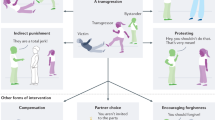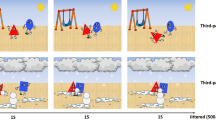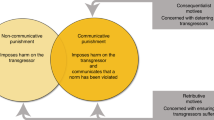Abstract
Protective interventions by a third party on the behalf of others are generally admired, and as such are associated with our notions of morality, justice and heroism1–4. Indeed, stories involving such third-party interventions have pervaded popular culture throughout recorded human history, in myths, books and movies. The current developmental picture is that we begin to engage in this type of intervention by preschool age. For instance, 3-year-old children intervene in harmful interactions to protect victims from bullies5, and furthermore, not only punish wrongdoers but also give priority to helping the victim6. It remains unknown, however, when we begin to affirm such interventions performed by others. Here we reveal these developmental origins in 6- and 10-month old infants (N = 132). After watching aggressive interactions involving a third-party agent who either interfered or did not, 6-month-old infants preferred the former. Subsequent experiments confirmed the psychological processes underlying such choices: 6-month-olds regarded the interfering agent to be protecting the victim from the aggressor, but only older infants affirmed such an intervention after considering the intentions of the interfering agent. These findings shed light upon the developmental trajectory of perceiving, understanding and performing protective third-party interventions, suggesting that our admiration for and emphasis upon such acts — so prevalent in thousands of stories across human cultures — is rooted within the preverbal infant’s mind.
This is a preview of subscription content, access via your institution
Access options
Access Nature and 54 other Nature Portfolio journals
Get Nature+, our best-value online-access subscription
$29.99 / 30 days
cancel any time
Subscribe to this journal
Receive 12 digital issues and online access to articles
$119.00 per year
only $9.92 per issue
Buy this article
- Purchase on Springer Link
- Instant access to full article PDF
Prices may be subject to local taxes which are calculated during checkout




Similar content being viewed by others
References
Walker, L. J. & Henning, K. H. Differing conceptions of moral exemplarity: just, brave, and caring. J. Pers. Soc. Psychol. 86, 629–647 (2004).
Darley, J. M. & Pittman, T. S. The psychology of compensatory and retributive justice. Pers. Soc. Psychol. Rev. 7, 324–336 (2003).
Wenzel, M., Okimoto, T. G., Feather, N. T. & Platow, M. J. Retributive and restorative justice. Law Hum. Behav. 32, 375–389 (2008).
Kinsella, E. L., Ritchie, T. D. & Igou, E. R. Lay perspectives on the social and psychological functions of heroes. Front. Psychol. 6, 130 (2014).
Vaish, A., Missana, M. & Tomasello, M. Three-year-old children intervene in third-party moral transgressions. Br. J. Dev. Psychol. 29, 124–130 (2011).
Riedl, K., Jensen, K., Call, J. & Tomasello, M. Restorative justice in children. Curr. Biol. 25, 1–5 (2015).
Woodward, A. L. Infants selectively encode the goal object of an actor’s reach. Cognition 69, 1–34 (1998).
Kanakogi, Y. & Itakura, S. Developmental correspondence between action prediction and motor ability in early infancy. Nat. Commun. 2, 341 (2011).
Csibra, G. Goal attribution to inanimate agents by 6.5-month-old infants. Cognition 107, 705–717 (2008).
Premack, D. & Premack, A. J. Infants attribute value ± to the goal-directed actions of self-propelled objects. J. Cogn. Neurosci. 9, 848–856 (1997).
Hamlin, J. K., Wynn, K. & Bloom, P. Social evaluation by preverbal infants. Nature 450, 557–559 (2007).
Hamlin, J. K., Wynn, K., Bloom, P. & Mahajan, N. How infants and toddlers react to antisocial others. Proc. Natl Acad. Sci. USA 108, 19931–19936 (2011).
Thomsen, L., Frankenhuis, W. E., Ingold-Smith, M. & Carey, S. Big and mighty: preverbal infants mentally represent social dominance. Science 331, 477–480 (2011).
Mascaro, O. & Csibra, G. Representation of stable social dominance relations by human infants. Proc. Natl Acad. Sci. USA 109, 6862–6867 (2012).
Kanakogi, Y., Okumura, Y., Inoue, Y., Kitazaki, M. & Itakura, S. Rudimentary sympathy in preverbal infants: preference for others in distress. PLoS One 8, e65292 (2013).
Scarf, D., Imuta, K., Colombo, M. & Hayne, H. Social evaluation or simple association? Simple associations may explain moral reasoning in infants. PLoS One 7, e42698 (2012).
Dunfield, K. A. & Kuhlmeier, V. A. Intention-mediated selective helping in infancy. Psychol. Sci. 23, 967–972 (2010).
Hamlin, J. K. Failed attempts to help and harm: intention versus outcome in preverbal infants’ social evaluations. Cognition 128, 451–474 (2013).
Flack, J. C., de Waal, F. B. M. & Krakauer, D. C. Social structure, robustness, and policing cost in a cognitively sophisticated species. Am. Nat. 165, E126–E139 (2005).
Rohr, C. R. et al. Impartial third-party interventions in captive chimpanzees: a reflection of community concern. PLoS One 7, e32494 (2012).
Flack, J. C., Girvan, M., de Waal, F. B. M. & Krakauer, D. C. Policing stabilizes construction of social niches in primates. Nature 439, 426–429 (2006).
Chudek, M. & Henrich, L. Culture–gene coevolution, norm-psychology and the emergence of human prosociality. Trends Cogn. Sci. 15, 218–226 (2011).
Cowell, J. M. & Decety, J. Precursors to morality in development as a complex interplay between neural, socioenvironmental, and behavioral facets. Proc. Natl Acad. Sci. USA 112, 12657–12662 (2015).
Powell, L. J. & Spelke, E. S. Preverbal infants expect members of social groups to act alike. Proc. Natl Acad. Sci. USA 23, E3965–E3972 (2013).
Meristo, M. & Surian, L. Infants distinguish antisocial actions directed towards fair and unfair agents. PLoS One 9, e110553 (2014).
Kuhlmeier, V., Wynn, K. & Bloom, P. Attribution of dispositional states by 12-month-olds. Psychol. Sci. 14, 402–408 (2003).
Gergely, G., Nadasdy, Z., Csibra, G. & Biro, S. Taking the intentional stance at 12 months of age. Cognition 56, 165–193 (1995).
Acknowledgements
This research was supported by the Japanese Science and Technology Agency (JST) CREST program for K.H., the Japanese Society for the Promotion of Science (JSPS) for K.H. (no. 16H01482), a MEXT Grant-in-Aid for Scientific Research on Innovative Areas “Constructive Developmental Science” to M.M-Y. (no. 24119005) and the Mayekawa Houonkai Foundation to M.M-Y. (2015–2016). The funders had no role in study design, data collection and analysis, decision to publish, or preparation of the manuscript. We thank N. Nakao for his comments on an early draft and H. Fukuyama, M. Imafuku, Y. Nishimura, N. Kawahara and Y. Tanaka for their assistance with data collection.
Author information
Authors and Affiliations
Contributions
Y.K., Y.I. and G.M. designed the study, supervised by K.H and M.M-Y. Y.K. performed the experiments. Y.K. analysed the data. Y.K. and D.B. drafted the paper, and all authors discussed the results and commented on the final manuscript.
Corresponding author
Ethics declarations
Competing interests
The authors declare no competing interests.
Supplementary information
Supplementary Information
(PDF 380 kb)
Supplementary Movie 1
(MOV 1312 kb)
Supplementary Movie 2
(MOV 1330 kb)
Supplementary Movie 3
(MOV 1258 kb)
Supplementary Movie 4
(MOV 1267 kb)
Supplementary Movie 5
(MOV 949 kb)
Supplementary Movie 6
(MOV 934 kb)
Supplementary Movie 7
(MOV 968 kb)
Supplementary Movie 8
(MOV 951 kb)
Supplementary Movie 9
(MOV 1346 kb)
Supplementary Movie 10
(MOV 1348 kb)
Rights and permissions
About this article
Cite this article
Kanakogi, Y., Inoue, Y., Matsuda, G. et al. Preverbal infants affirm third-party interventions that protect victims from aggressors. Nat Hum Behav 1, 0037 (2017). https://doi.org/10.1038/s41562-016-0037
Received:
Accepted:
Published:
DOI: https://doi.org/10.1038/s41562-016-0037
This article is cited by
-
Preverbal infants’ understanding of social norms
Scientific Reports (2024)
-
Human and animal dominance hierarchies show a pyramidal structure guiding adult and infant social inferences
Nature Human Behaviour (2023)
-
Third-party punishment by preverbal infants
Nature Human Behaviour (2022)
-
Children as assessors and agents of third-party punishment
Nature Reviews Psychology (2022)
-
Preverbal infants expect agents exhibiting counterintuitive capacities to gain access to contested resources
Scientific Reports (2021)



